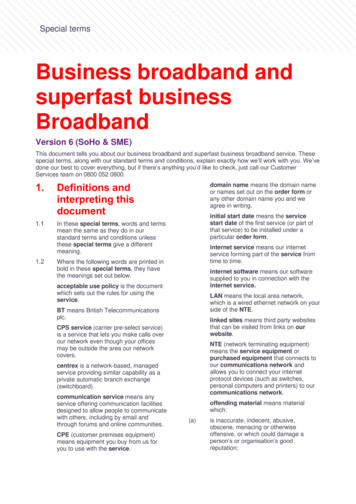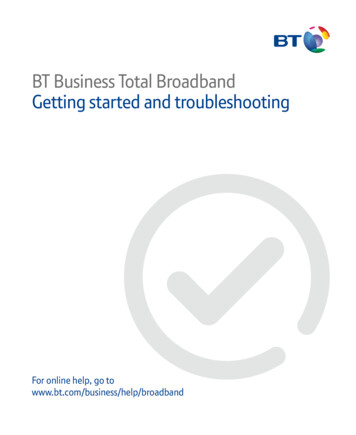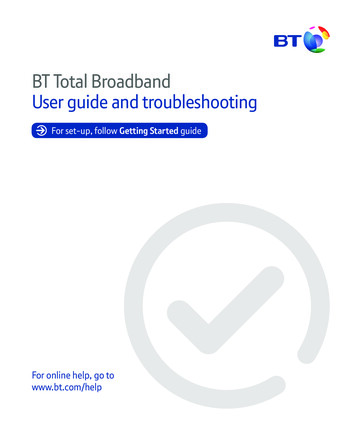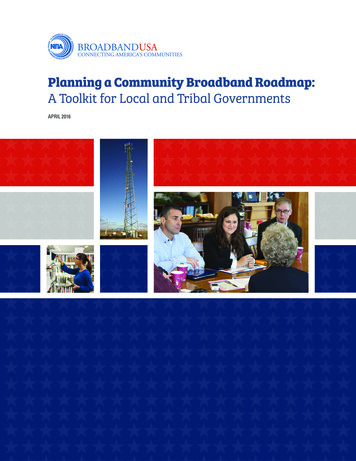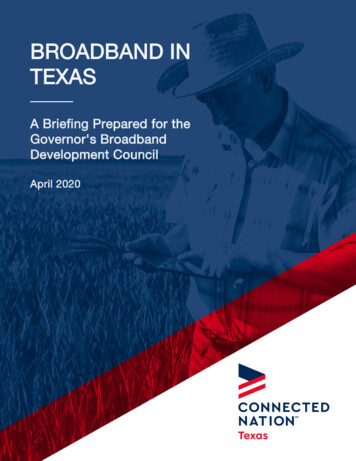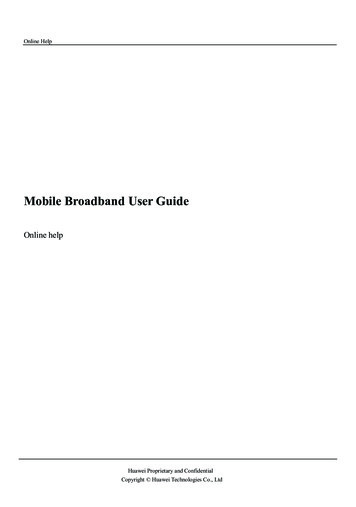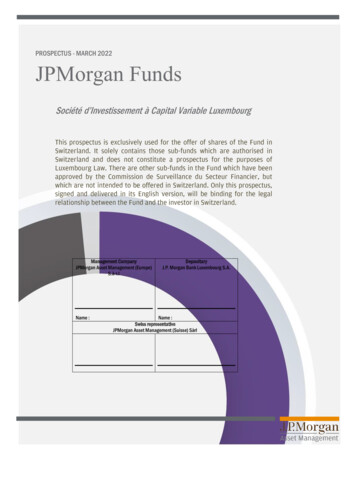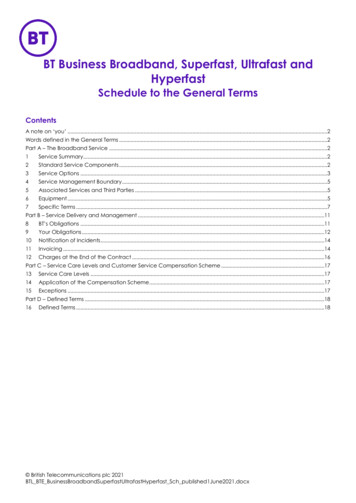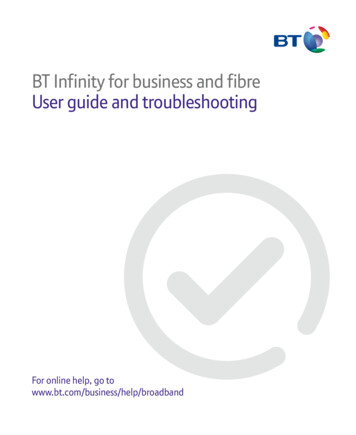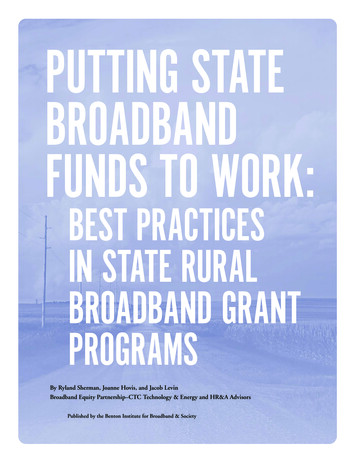
Transcription
PUTTING STATEBROADBANDFUNDS TO WORK:BEST PRACTICESIN STATE RURALBROADBAND GRANTPROGRAMSBy Ryland Sherman, Joanne Hovis, and Jacob LevinBroadband Equity Partnership–CTC Technology & Energy and HR&A AdvisorsPublished by the Benton Institute for Broadband & Society
Putting State Broadband Funds to Work:Best Practices In State Rural Broadband Grant ProgramsThis report was written by Ryland Sherman, Joanne Hovis, and Jacob Levinand published by the Benton Institute for Broadband & Society.June 20211041 Ridge Road, #214Wilmette, IL 60091This work is licensed under the Creative Commons Attribution-Noncommercial 3.0 United States License.A copy of this license is available at creativecommons.org/licenses/by-nc/3.0/us/Please include the following attribution when citing this report:Sherman, Ryland; Hovis, Joanne; and Levin, Jacob. “Putting State Broadband Funds to Work: Best Practices InState Rural Broadband Grant Programs.” Evanston, IL: Benton Institute for Broadband & Society, June s
Ryland Sherman, a broadband economics and policy researcher at CTC Technology & Energy, focuseson federal and state broadband strategy and policy frameworks; mapping and funding programs;and digital equity initiatives. Prior to joining CTC, he provided significant research support for thedevelopment of the Benton Institute for Broadband & Society’s comprehensive broadband agenda,Broadband for America Now, analyzing broadband competition issues and the economic impacts ofbroadband. He holds a Ph.D. and a law degree from Indiana University’s Media School and MaurerSchool of Law, respectively.Joanne Hovis is president of CTC Technology & Energy, where she heads the firm’s work in publicbroadband strategy, network business planning, market analysis, and policy. Joanne advises statesand local governments on how to build strategy and opportunity for public–private partnershipsin broadband. She leads the CTC teams that have developed broadband strategic guidance for thestates of Alabama, Connecticut, Delaware, Georgia, Maryland, New Mexico, and Vermont. Joanne isco-founder of the Broadband Equity Partnership and serves as CEO of the Coalition for Local InternetChoice. She is also on the boards of Consumer Reports, the Fiber Broadband Association, and theBenton Institute for Broadband & Society.Jacob Levin is a senior analyst at CTC Technology & Energy, where he develops policy proposals,market analyses, and broadband strategy for local and state government clients. He relies on industryexperience and market research to model ongoing costs and revenue opportunities associated withbroadband investments, and to develop resilient business models in the public interest. He has helpedclients across the country develop public-private partnerships that achieve key policy goals whileminimizing public exposure to risk. His research focuses on trends in the broadband industry andtheir impact on public sector actors like municipal fiber owners, research and education networkoperators, and anchor institutions.The Broadband Equity Partnership is a mission-driven consultancy founded by HR&A Advisorsand CTC Technology & Energy following three years of collaboration and the development of NewYork City’s Internet Master Plan. Our work builds capacity in federal, state, and local governments,institutions, community organizations, and internet service businesses to accelerate universalbroadband and digital inclusion.The authors wish to thank the states of Maryland, Connecticut, New Mexico, Alabama, Delaware,and Vermont, for whom elements of this analysis were developed at various points over the past halfdecade. The additional work undertaken to develop this paper is dedicated to the broadband plannersfor those states, whose efforts have served as models for the nation.
ContentsExecutive Summary . 5I. Program Planning Phase . 9Create a structure to plan, engage stakeholders, and execute strategy . 9Develop the best possible data and mapping resources . 11Set clear, measurable goals .11Engage small- and medium-sized broadband providers early and develop a pipeline of diverse applicants .12II. Program Design Phase .131. Maximize matching investments and federal synergies .132. Prioritize scalable infrastructure .143. Offer planning grants .154. Create means to identify and fund overlooked locations, including unserved pockets withinotherwise served areas.165. Prevent challenge process abuses.166. Prioritize local input and incent collaboration.177. Ensure a predictable flow of funding .178. Integrate affordability, digital equity, and economic development into scoring criteria .18III. Program Execution, Monitoring, and Adjustment Phase . 20Evaluate deployment performance to refine grant processes . 20Adapt the program in light of lessons learned and new circumstances .21Fine-tune the program’s relationship with other programs .22Endnotes . 23
Executive SummaryAfter a year of pandemic and crisis, the scale of our national digital divide1 is at last recognizedby policymakers at all levels, with federal, state, and local governments making unprecedentedcommitments to narrow the divide.While most of the funds to address these challenges flow from the federal government, it is at the stateand local levels where remarkable innovation has developed.Particularly critical in this moment are state-level efforts to distribute federal funds and incubate localinitiatives.Those states that have long-established programs for addressing rural broadband gaps offer a valuablehistory of lessons learned, both of what works and what doesn’t. Through more than a decade ofsignificant efforts and experimentation in broadband funding strategies, new innovations and trendshave emerged that offer insight to best practices for other states that are developing new rural broadbandfunding programs or retooling existing programs.Given this rich set of data and experience, this paper describes the commonalities among many of the beststate rural broadband funding programs and recommends best practices. In subsequent case studies to bepublished online later this year, we will illustrate these programs and practices in more depth.Background: States organize to facilitate and fund local effortsIndeed, over the past decade, a range of states have developed and executed strategies to methodicallychip away at rural broadband challenges. These states have formed broadband task forces; they havebrought stakeholders together to gauge needs; they have stood up state broadband offices to putsophisticated strategies into action; and they have provided information and resources to localities,community anchors, and the public.Some states have gone one step further: They have invested substantial public dollars, through grantprograms, to fund broadband deployments in areas that lack adequate service. By providing statefunding to match private investment and federal grants, these states have enabled deployment in areasthat cannot attract sufficient private investment. Through financial incentives and accurate data,states such as Minnesota, Maryland, and Alabama have incented the private sector to collaborate withlocal communities in addressing broadband deficits.Elements: Successful state broadband programs have similar attributesState funding programs have proved effective through multiple stages of the broadband deploymentprocess. Broadband planning grants help towns and cities to evaluate local conditions and develop the5
plans and partnerships to apply effectively for federal and broadband grants. Broadband infrastructuregrants provide capital to deploy new facilities to fill service gaps, based on community and economicdevelopment goals.While this document analyzes a wide range of best practices, three major trends in particular areworth emphasizing. First, state development funding programs have increasingly integrated digitalequity and economic development considerations into each stage of the funding program developmentprocess. Grant programs that previously had focused solely on deployment costs have expanded toinclude consideration of digital inclusion and economic benefits—to low-income communities, farms,small businesses, and teleworkers—thus also enabling grantees to compete for federal programs thatfocus on such metrics, including that of the Economic Development Administration (EDA), whichrequires careful evaluation of economic impacts.Second, early restrictions on the types of organizations that could apply for deployment grants havebeen replaced by broad, inclusive eligibility criteria that recognize the value of innovative collaborationsamong a range of entities, including electric cooperatives, local governments, and private companies.For example, California once required that funding applicants possess a Certificate of PublicConvenience and Necessity (CPCN) or a Wireless Identification Registration (WIR), effectivelyrestricting the program to companies offering wireline telephone or cellular telephone services.2 Thatrestriction excluded newer broadband competitors and municipalities, thus reducing the number ofapplications far below available funding and resulting in far more investment by grantees in middlemile infrastructure than in critically needed last-mile connections to unserved homes and businesses.3Now, California welcomes a much broader set of applicants, and its program performance has improvedsignificantly.4Third, the best state funding programs include a critical role for local governments and communities,working in collaboration with private partners, to ensure local input, benefit from local insights, andbring to bear local assets and resources. Indeed, the past decade of experimentation has given rise toa range of cooperative agreements between localities and private entities. Many of the best state grantprograms provide flexibility for business structures that include public-private partnerships and otherinfrastructure access and management agreements. These new organizational forms allow adaptationto reflect the needs and resources of each party involved, while leveraging benefits in financing andpermitting available to such hybrid forms. Many states welcome these flexible collaborations; Virginiaand Maryland actually require cooperation between a public and a private entity.5Process: Successful state broadband programs follow established pathsEffective state broadband funding programs are not formed overnight. They are the result of research,conversations, and coordination with myriad stakeholders, along with development of state-levelorganizations capable of working with communities and internet service providers (ISP).Generally, successful broadband funding programs have progressed through three key stages: first,planning and research to understand challenges and build strategy; second, program design; and third,execution, monitoring, and adjustment.6
PROGRAM PLANNING PHASECREATE STRUCTURE TO PLAN,ENGAGE, AND EXECUTEDEVELOP DATA AND MAPSENGAGE PROVIDERS ANDDEVELOP PIPELINESET GOALSPROGRAM DESIGN PHASEMAXIMIZEMATCHING ANDFEDERAL GRANTSADDRESS SMALLUNSERVEDPOCKETSPREVENTCHALLENGEPROCESS INTEGRATEAFFORDABILITYIN SCORINGPROGRAM EXECUTION, MONITORING, and ADJUSTMENT PHASEEVALUATE DEPLOYMENT PERFORMANCETO REFINE GRANT PROCESSESADAPT TO NEW CIRCUMSTANCESCOLLABORATE WITH OTHER PROGRAMSStages of Successful State Broadband Funding ProgramsIn the first stage, states must develop an overall broadband plan that identifies where improvedconnectivity is most needed and how those needs should be met. To understand these needs and possibleconnectivity solutions, the state’s multistakeholder broadband planning group and administrativebroadband office must coordinate with a variety of stakeholders, including the state’s businesscommunity, anchor institutions, local leadership, and the ISPs themselves. A formal broadbandmapping and digital equity assessment program then enable the state’s broadband policymakers todevelop more specific goals and priorities necessary to evaluate more technical deployment issues andthe state’s broadband funding needs.In the second stage, states design the structure and rules of their broadband funding programs tomeet these goals. To ensure that the state’s resources can be utilized to their fullest, the deploymentgrant evaluation process should reward funding competitively to the proposals that offer the bestcombination of broadband capabilities to the areas most in need at the lowest cost to the state. Mostreviewed state programs established strong incentives for deployments to seek additional federal supportand reduce deployment costs by working closely with municipalities to leverage their local knowledgeand resources. State planning grants are frequently offered to improve deployment strategies and costestimates and facilitate federal grant awards. Other well-chosen eligibility characteristics establishlocation preferences, ensure that only scalable broadband technologies capable of meeting future needsare deployed, and enable a variety of more flexible deployment strategies and partnerships to be used.In the third stage, states execute their grant strategies and then revise and adjust them for furtherrounds of funding to incorporate lessons learned in earlier rounds. For example, states have learnedfrom experience with cost-saving deployment technologies such as micro-trenching, enabling existingfunding programs to make a greater impact. Some states have updated their definitions of “unserved”and “underserved” to reflect best practices and to meet rapidly increasing household broadband needs.6Others have increased the technical requirements for new deployments to ensure that state-assisteddeployments can scale to meet bandwidth needs over the next decade and beyond.77
States do not progress through these stages uniformly. For example, whereas Minnesota’s grantprogram was initially developed from nearly a decade of prior state-level strategy development, Illinoismoved from planning to grant program execution quickly and efficiently, in part because it benefitedfrom Minnesota’s lessons learned and best practices. Multiple iterations of the Minnesota broadbandtask force met from 2008 until the state created an administrative entity to execute broadband strategyin 2013, with initial infrastructure grant funding in 2015.8 The grant program has evolved by usingfeedback from prior grant cycles to fine-tune its approach and cultivate a pipeline of potential projects.In contrast, states such as Illinois and Virginia learned from Minnesota’s example9 and demonstratehow the time between planning and program execution can be dramatically reduced. Illinois’s 420million grants program was launched in 2019, following simultaneous development of the programand availability information-gathering, stakeholder outreach, and strategy development.10The range of state funding program structures is broad, as each state solution is customized to itsunique mix of needs, resources, and policy environment. To sort through this complexity, this paperdescribes a range of successful funding programs and suggests replicable elements in each stage. Thisanalysis is intended to serve as a resource for policymakers at state, local, and federal levels regardinglessons learned and best practices in broadband grant-making.8
I. Program Planning PhaseTo address their broadband connectivity needs, states devote significant resources to creatingcomprehensive broadband strategies. During the planning stage, they focus on developing theinformation they need to adapt funding program conventions to their circumstances. Best practicessuggest that this planning stage should focus on two primary yet interrelated elements: (1) evaluatingbroadband needs, and (2) understanding and coordinating resources across a large range of stakeholders.To properly address these elements, states place special emphasis on processes that will harnessinformation from industry, other state and federal agencies, potential broadband deployers, and thelocal underserved communities themselves. State officials reach out to this variety of public and privatestakeholders, then analyze availability, affordability, and digital equity issues, ultimately factoringthem into a single formulation of goals and solutions.These best practices have been demonstrated to improve coordination and understanding of the state’sbroadband deployment needs:Create a structure to plan, engage stakeholders, and execute strategyMost states have some combination of a broadband task force, broadband council, and state broadbandoffice to develop deployment and adoption strategies and administer their broadband programs.These organizations serve as the focal point to bring together the diverse needs and views of the state’sessential broadband stakeholders, but a list of essential stakeholders is not necessarily obvious. Broadbandaccessibility has become essential in so many facets of Americans’ lives that nearly every industry andgovernment agency has a stake in broadband policy. From online shopping, social networking, and newsto distance learning, telework, and access to government services, broadband connectivity has becomea required resource in our working and personal lives. Manufacturers and local businesses depend uponbroadband to connect to their customers and, increasingly, their own employees. Farms depend upon itas a vital part of their supply chains, a way to sell their produce and, increasingly, a method to controltheir automated machinery.11 Schools, colleges, and job training programs use it to connect to students,and state and federal education programs have developed their own programs and policies to facilitateconnectivity. Every major industry and governmental department relies on broadband availability insome way, and nearly all of them have something to say about broadband.To bring these disparate interests together to develop a unified approach, many states use multistakeholdertask forces to evaluate initial broadband needs, perform outreach, and develop strategies to satisfy thoseneeds. Later, a dedicated state broadband office typically is created to administer grant programs,mapping efforts, and digital equity initiatives.12Minnesota’s first task force in 2008 illustrates this multistakeholder approach. It was composed ofmembers representing schools, libraries, health care facilities, the rural and metropolitan business9
communities, wireline and wireless telephone and cable companies, and leadership from the state’scommerce, employment, and economic development departments.13 This task force met with a varietyof the state’s stakeholders and analyzed the broadband deployment strategies and policies of otherstates and countries to understand the range of issues they faced and identify best practices.14 Fromthis process, Minnesota’s resulting first major broadband strategy report emphasized that “[b]alancedcollaboration needs to be ‘baked in’ right from the beginning” of the strategy development process. 15As it explained:Minnesota cannot undertake alone all the actions required to achieve broadbandubiquity. What is required is a broad, and perhaps unique, collaboration between manystakeholders. The state has a variety of important roles to play, but so do the rest of thestakeholders.16This insight has been shared and adopted by most other state broadband programs, but its implementationhas generally occurred more swiftly. Whereas there was a five-year separation between the formationof Minnesota’s task force and its Office of Broadband Development (OBD), Illinois formed bothits Broadband Advisory Council and the Illinois Office of Broadband nearly simultaneously as ameans to evaluate its needs quickly and begin distributing a portion of its 420 million broadbanddeployment and connectivity fund. This 2019 Connect Illinois initiative is the best-funded of the stateprograms that employ a deployment grant application process and is an excellent example of morerecent coordination practices.17 The strategy-development-focused Broadband Advisory Council’s 25members include representatives from state agencies, various types of ISPs, and anchor institutions,which have enabled it to analyze the state’s connectivity challenges alongside its possible solutions.18While several states have established separate roles for a broadband task force and administrativebroadband office, others have taken a different approach to broadband policy coordination. Maine’slong-standing ConnectMaine Authority demonstrates that a multistakeholder strategy developmentcouncil does not need to be separated from the broadband office that administers its state’s programs.Since 2006, this organization has evaluated Maine’s broadband deployment needs, facilitated overallstate support for broadband development, and administered the state’s funding programs.19 Its boardconsists of Maine’s CIO as well as representatives from Maine’s university and health systems, itsDepartment of Economic and Community Development and Public Utilities Commission, theNational Digital Equity Center, and the Maine Broadband Coalition, the latter being a large group ofthe state’s businesses, nonprofits, and broadband advocates.20Proper funding program administration requires coordination with the state’s other economicdevelopment strategies. Some of the most successful broadband offices have been placed withintheir states’ economic and community development departments. When the Minnesota legislatureestablished the Office of Broadband Development (OBD) in 2013, it was placed within theDepartment of Employment and Economic Development (DEED), which has helped foster buy-infrom service providers.21 Building the program within an agency that has experience and expertisegiving and overseeing competitive grants has contributed to the success of Minnesota’s Border-toBorder Broadband Development Grant Program.22 Similarly, the Illinois Office of Broadband ishoused within the Illinois Department of Commerce and Economic Opportunity, the state’s largestgrant-making authority. Alabama, Missouri, Maryland, Tennessee, and Virginia’s broadband programsare also administered by their states’ economic and community development departments.2310
Develop the best possible data and mapping resourcesWhile federal grant programs have generally relied on service providers’ self-reported coverage maps toidentify areas of need, these maps are based on FCC Form 477 data, which features a number of systematicinaccuracies that have led to unserved areas being classified as served and thus ineligible for grant programs.Working with Missouri and Virginia, USTelecom in 2019 found that as many as 38 percent of rurallocations in census blocks reported to have broadband service actually did not.24 These broadband blindspots have been challenging for policymakers, because they often lie on the outskirts of served areas and arescattered, making them hard to identify or connect using traditional area-wide deployments.To find these blind spots, several states have developed their own mapping programs, gathered supplementaldata, or taken steps to ensure that existing data is more accurate and useful to broadband grant processes.For example, Alabama is currently engaged in one of the most ambitious mapping programs in the country,developing service data at the address level. Georgia completed a similar undertaking in 2019 and maintainsa map at the address level that allows for surgical analysis of which areas require funding.25 Minnesota hasmaintained its own mapping for at least a decade, with considerable data reporting obligations for privateservice providers in the state.26 The California Public Utilities Commission maintains maps of the state’sremaining unserved areas and monitors the deployment processes and adoption rates where state funds aredeployed.27 Maine supplements its maps with additional mapping information developed by organizationsreceiving the state’s planning grants and provides a process to identify additional unserved areas.28 Virginia’sbroadband maps were developed by Virginia Tech and the Virginia Geographic Information Network,using information from a broadband mapping initiative with U.S. Department of Commerce’s NationalTelecommunications and Information Administration (NTIA) and other sources.29These maps often offer enhanced features that allow state and local broadband planners to improvethe coverage and accuracy of their grant programs. California, Minnesota, and other states’ interactivemap programs actively provide information about areas eligible for their grant programs and a numberof other useful metrics to understand availability.30 Some states also make their more detailed data setsavailable for download.31 Many states without their own significant mapping programs are in the processof developing them. As of February 2021, 30 states are working with NTIA to improve their mappingprograms and data availability.32Although not robust enough to develop comprehensive maps, state speed test sites allow users to verifywhether they are able to use claimed service speeds and enable states to gather information useful forfunding prioritization and other broadband policymaking. Maine, Maryland, Minnesota, New York, NorthCarolina, Washington, and several other states provide speed test links to enable state residents to contributeavailability information.33 Pennsylvania used its speed test data more systematically to highlight areas whereForm 477 data significantly overreported availability.34 California provides the public with an opportunityfor feedback to its custom measurement platform and a speed test process for mobile broadband services.35Set clear, measurable goalsAfter stakeholder outreach and data gathering, states generally publish a significant strategy document.These strategy reports often declare connectivity goals for the state, including clear definitions of whatis sufficient to meet the broadband needs in future decades. Once these broad goals are established,11
the legislature and broadband funding program designers can better estimate the size and scope ofappropriations necessary to fund such major undertakings.Indeed, some states have forward-looking performance requirements that surpass the FCC’s increasinglyoutmoded definition of minimum broadband performance set in 2015.36 Vermont has established afuture-looking goal of 100/100 for all Vermonters.37 Minnesota has established the goal of ubiquitousaccess to broadband at speeds of at least 100/20 Mbps across the state by 2026, with a goal of rankingin the top five in the nation for speed and access.38Some states also established additional goals for improving broadband in “underserved” areas—thatis, areas that may have access to 25/3 broadband, but not service that meets state goals. For example,Minnesota and Illinois consider as “underserved” areas that do not have access to 100/20 Mbps service,making grant funding available to these areas as well.39,40Engage small- and medium-sized broadband providers early and developa pipeline of diverse applicantsState experience demonstrates that inclusion of potential applicants is vital. Broadband grant applicationsare often the result of years of effort to reach and engage these various groups, from early efforts to solicitstakeholder input to the specific deployment choices resulting from long-term coordination.Not all potential broadband providers have the sa
BEST PRACTICES IN STATE RURAL BROADBAND GRANT PROGRAMS PUTTING STATE BROADBAND FUNDS TO WORK: By Ryland Sherman, Joanne Hovis, and Jacob Levin Broadband Equity Partnership-CTC Technology & Energy and HR&A Advisors Published by the Benton Institute for Broadband & Society. This work is licensed under the Creative Commons Attribution-Noncommercial 3.0 United States License. A copy of this .
